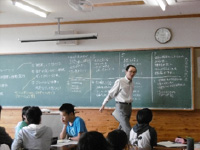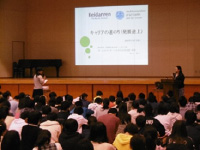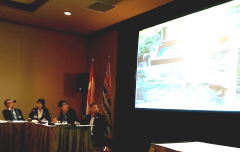SGH Program Interim Report for the 2015-2516 School Year
I. Activities from September to November
I-i. Lessons
1. Research Projects
(1) "Nagano's Global Strategy Seen from an International Perspective" (During "Integrated Studies" hours)
- Credits and Lesson Hours: One Credit for two Lessons (Two consecutive 55 min. periods) every two weeks
- Subject: Second year students
- Aims
Students will deepen and further develop the thinking, decision-making, problem-solving, and communication skills they cultivated during their first-year research project, "Investigating Nagano's Global Strategy," while also adding a new "international perspective" in pursuing comparative research between Nagano and foreign countries. They will also carry out projects, applying the results of their research for making proposals and reports. - Lessons
They continued research activities through their fieldwork from April to September in order to carry out a project to solve problems they found throughout the activities during the first year. In October and November, they moved into the implementation phase to present the summary of their two-year research project based upon their findings.
- ①Scheduling and confirming the procedure for the presentation, and preparing or implementing the project (Wednesday, October 7)
- Goals: To make a schedule for the projects and the presentation, and check their required tasks.
To learn, think and experience problem-solving methods while carrying out their projects to solve problems. - Content: In the first half of the class, with the help of the group advisors the students made a schedule of the remaining classes for the presentation (four lessons), proceeded with the projects, and checked some points including assigning each student their work for making slides for the presentation.
In the last half of the class, they prepared and implemented the project to solve the problems, using information-generating methods they learned in the previous class. - Results: There were not many classes left before the Research Project presentation. There were some differences in how far each group proceeded became noticeable.
Scheduling made the groups left behind have a proper understanding of their own situations. There were still only few groups that proceeded to the final stage or completed their projects. The results have, however, gradually become clear.
- Goals: To make a schedule for the projects and the presentation, and check their required tasks.
- ②Making reports on their research projects and preparing the presentations (Creating PPT files & texts for presentation) (Wednesdays, October 21 and November 4)
- Goal: To make comprehensive presentations of research and fieldworks at the first year, and of projects at the second year
- Content: They made summaries of results from two-year activities and prepared the presentations, using Power Point files.
- Results: At the study phase, the role of each group member was not clear and there seemed to be a gap in how much the students contributed to the projects. At the summary, however, the tasks were successfully assigned to the students so that they could work for making slides and information materials for the project. We need to work on how they can actively get involved in their tasks even at the study phase.
- ③Run-through (Wednesday, November 11)
- Goal: To make a final check on the presentations, including the contents, the structure, and the manner.
- Content: They made their presentations in the exactly same way as the actual one. After the rehearsal, their group advisors gave advice to them.
- ④Research presentations (at Zenkoji Temple Global Pre-summit) (Thursday, November 12)
- Goal: To make presentations as the comprehensive result of the two-year research activities on what they have learned, using the presentation skills they have acquired through the projects.
- Content:
○13:40 - 14:55 Group discussions: 59 groups presented their research at 15 sites. All the students from the first and second years joined the discussions.
○15:15 - 1640 General meeting: Designated four groups had a presentation (three groups in English). They discussed their own topics with all the students from the first and second year and the guest participants, who are foreign exchange students and those from other high-schools), followed by some reviews from three instructors.
○One example of the presentations from the general meeting: Pillars of Longevity
Tasks: To explore the causes for being the longevity prefecture of NAGANO from the views of "administration," "health care," and "people.".
To compare Japan to other countries in the world.
Current State: The reality of longevity viewed from statistical data, and news coverage reported by press as its causes
Research 1: They did fieldworks at New Life Hospital in Obuse to explore the current situation of "health care"
The importance of preventive medicine -> Having a good lifestyle, and having a strong desire to live in order to have a good lifestyle
Research 2: They made an interview with Mr. Akira Sugenoya, the mayor of Matsumoto City, to explore the current situation of "administration."
The health care administration the Matsumoto city seeks for is a citizen-centered administration while the city should remains behind the scenes.
Research 3: They did fieldworks in Chikuhoku-mura, Higashi-chikuma-gun, to explore the current situation of "people."
Growing herbs as part of health promotion, and growing communication among residents through the herb-growing activity
Conclusion: They found that everyday affairs are more important than special ones, which means the power of basic lifestyle generated from the strong desire to actively make your own life more fulfilled.
(2) "Investigating Nagano's Global Strategy" (During "Integrated Studies" hours)
- Credits and Lesson Hours: One Credit for two Lessons (Two consecutive 55 min. periods) every two week
- Subject: First year students
- Course Objectives
- ①Acquire the skills and diverse perspectives needed to pursue research activities
- ②Through research activities, learn thinking, decision-making, expressive, problem-solving, and communication skills
- ③By reexamining the local Nagano area from a global perspective, discover new values and gain the ability to act from a broad, deep perspective.
- Lessons
- ①Main points from September to November
- Identified as "a period for exploring a theme of Research Projects II during the later-half phase"
- Based upon their future as well as what they want to study at university, the students were asked to individually think up a research field and theme, using examples from themes shown by SGH Project Team
- The communication with the students was through SGH Newsletters and SGH staff meetings except on Saturday, September 19. This is because there were weeks with no integrated classes in a row for the first year students.
- ②"Global Career" (Saturday, September 19)


- Goals: For the first year students are faced with career path selection quite soon, and they need to think of their own "occupation." After learning that global elements are inevitable for global occupations in the future, they met and listened to people who work globally and carefully thought about their own career based on their stories.
- Content:
○ Group works: They exchanged their opinions and mapped out following themes in groups:1. What is "an occupation"? What are the global elements which are inevitable for the occupation; 2. What do you want to be? What do you want to do as a job; 3. What kind of ability do you need to work globally?
○ Lecture by Ms. Teruko Wada, Senior Chief Staff of International Affairs Bureau, Japan Business Federation (Keidanren) / Member of World Board, World Association of Girl Guides and Girl Scouts, with the title of "A graduate talks about the best parts of global careers: Choose a career path more meaningfully." Based upon her experiences, she explained difficulty, challenging, necessary qualification, abilities to be developed, and the importance of the local network for global careers. The parents who wanted to come were also invited to the lecture. - Results: Through the group work activities, many of the students recognized the social and personal meanings of "career," comparing to "works." The lecturer gave tips about how to completely wear two hats at the frontline of global business, and her talks impressed a lot of the students. They firmly nodded when she explained that English is just a tool, and that the most important things are to gain insight into different cultures and to closely observe other people.
- ③The first meeting for the fieldwork (Friday, October 2)
- Goals: To provide some possible themes for Research Projects II, and to let the students know about the importance of Research Projects II.
- Content: We provided the students with the project fields and some examples of possible themes. Base on the information, we let them think about how to make groups, whether they should recruit other group members by themselves, or they should be grouped according to fieldwork destinations suggested by the SGH Project Team.
- Results: Their awareness of Research Projects II got boosted. We learned that there were several students who wanted to study their own research themes by recruiting group members.
- ④The second meeting for the fieldwork (Tuesday, October 13)
- Content: We investigated what areas the students wanted to research, and who wanted to research their own theme and to recruit group members by themselves. We provided them with fieldwork destinations.
- Results: We learned that the number of students for areas of "Community Building" and "Arts" were drastically small, so both of the fields did not have sufficient number to make a group.
In addition, we learned that there are about 20 students, who want to recruit group members by themselves. They were told that the group members would be determined by October 23.
- ⑤The third meeting for the fieldwork (Thursday, October 22)
- Content: We explained the way of grouping, and showed the details of courses in the fieldwork areas.
- Results: Students who were interested in the same field got together, and then voluntarily discussed the grouping based upon the courses in the fieldwork areas.
- ⑥Guidance (Wednesday, October 28)
- Goal: To assemble students who made groups by themselves by recruiting, and to explain how to proceed with their projects.
- Content: We instructed the students to find the fieldwork destinations by themselves, and showed them how to make appointments and further procedures.
- Results: There were 18 students from five classes who voluntarily made groups. They decided themes and started to make appointments voluntarily.
- ⑦The fourth meeting for the fieldwork (Thursday, October 29)
- Content: We finally decided members of each group, and investigated which course of the areas each group wanted to study.
- Results: All groups for Research Projects II were decided.
- ⑧The fifth meeting for the fieldwork (Monday, November 9)
- Content: The students were informed about the result of grouping and the fieldwork destinations for each group.
| Groups | Research Areas | Fieldwork Destinations |
|---|---|---|
| A-1 | Sports | M-WAVE Corporation , Minami Nagano Sports Park |
| A-2 | Shinshu Sports Spirit , M-WAVE Corporation | |
| B-1 | Food & Agriculture | Yawataya Isogoro LTD., Nagano Agricultural Experiment Station & Fruit Tree Experiment Station |
| B-2 | St. Cousair |
|
| C-1 | Production goods & Science technologies | SHINKO ELECTRIC INDUSTRIES CO.,LTD. , Fujikoshi Machinery Corp. |
| C-2 | Aoki Technical Laboratory, Inc. , Takeuchi Mfg. Co., Ltd. | |
| E | Nature, Environment & Energy | Miyama , Nagano Environmental Conservation Research Institute |
| F | Education & Art | Division of Education, Shinshu University , Green Hills Elementary & Junior High Schools, Iizuna Gakuen Educational Foundation |
| G-1 | History & Culture | Zenkoji Temple , Nagano City Museum |
| G-2 | Nagano Prefectural Museum of History | |
| H-1 | Medical care & Health | MIYARISAN PHARMACEUTICAL CO., LTD. , Nagano Red Cross Hospital |
| H-2 | Kotobuki Pharmaceutical Co., Ltd. , New Life Hospital |
- Schedule of Research Projects II
- ①Preparatory study of fieldwork
- It is necessary for individual awareness and knowledge to be improved in order to work together and get the research project proceeded. Before the preparatory study for fieldwork, each student should collect newspaper articles related to her/his research area, and have her/his own opinions and interests to the problem.
- The students must be forced to collect necessary information from secondary sources.
- ②Post study of fieldwork
- With the ability to "crash," or discuss, which they have developed through English Language Projects I, the quality of presentations and Q&A should be enhanced through discussions in a group and between groups.
- ③Schedule of integrated study hours
Tuesday, November 17 & Wednesday, November 18: Preparatory study of fieldwork
Tuesday, December 1: Preparatory study of fieldwork
Wednesday, December 2: Actual fieldwork
Thursday, December 3: Summary of the fieldwork
December ~ January: Preparation for the presentation of Research Project II, such as further thoughts and observations of the project.
Tuesday, February 2 & Wednesday, February 3: Presentation of Research Project II
2. Special SGH Subjects
(1) Global Economy
- Credits and Lesson Hours: One credit
- Subject: First year students
- Goals: To acquire the knowledge needed to understand globalization and gain a deeper awareness of how to live as a member of global society by actively considering fundamental problems of modern society.
- Lesson Content:
September ~ November: Through lectures and exercises, they studied how and why the economic liberalism had expanded its power and the socialist planned economy had lost its power while the post WW2 system had been established.
(2) English Language Projects II
- Credits and Lesson Hours: One credit
- Subject: First year students
- Goals: To enable students to acquire an attitude of active communication as well as information literacy, the ability to understand and convey information, and the ability to utilize information and communication (ICT) technology through English.
- Lesson content:
September ~ November: They prepared their presentations for school exchange activities during the study tour to Taiwan.
Each student made her/his own presentation slides using Google Apps for group exchange activities with seven senior high schools in Kaohsiung City. The students prepared group presentations and made the management plan for the day. They started to exchange comments or skyped with their partner group members, using slides.
(3) English Language Projects I
- Credit and Lesson Hours: One credit
- Subject: First year students
- Goals: To acquire a global sensibility through assigned research in English, and learn the basic skills for making presentations in English utilizing the latest digital media.
- September ~ November: Academic debates
Resolution: "As for a study tour, traveling abroad is better than traveling domestically."
The theme and method remained same as what they had learned at Debate and Basic Research Skills from Research Project I, but they learned the contents more deeply and mastered them. They used some of the advanced digital media to get the evidence supporting their side. At the end of November, their debates will be done in a contest style. (In the next school year, a "class vs class" debate contest will be held at Kinshi-sai, the school festival.)
I-ii School Events / Off-campus Events
Sending our students to the general meeting of Olympic Museums Network (IOC-OMN)

In Richmond, Canada, on Thursday, September 24 and Friday, September 25
Out of 12 applicants of second year students, two students were selected as envoys who made presentations in English about how M-WAVE's Olympic memorial room was able to join the Network at the OMN general meeting. They explained how the memories of Nagano Olympics have been passed on to younger generations, and how the M-WAVE's joining OMN would affect the younger generation. In addition, they answered questions from the members at the Q&A session, which helped M-WAVE become a member of OMN as the first Japanese organization. Their presentations were very favorably accepted at the general meeting.
Out of 12 applicants of second year students, two students were selected as envoys who made presentations in English about how M-WAVE's Olympic memorial room was able to join the Network at the OMN general meeting. They explained how the memories of Nagano Olympics have been passed on to younger generations, and how the M-WAVE's joining OMN would affect the younger generation. In addition, they answered questions from the members at the Q&A session, which helped M-WAVE become a member of OMN as the first Japanese organization. Their presentations were very favorably accepted at the general meeting.
